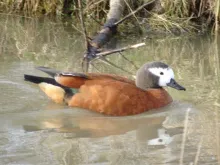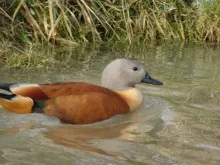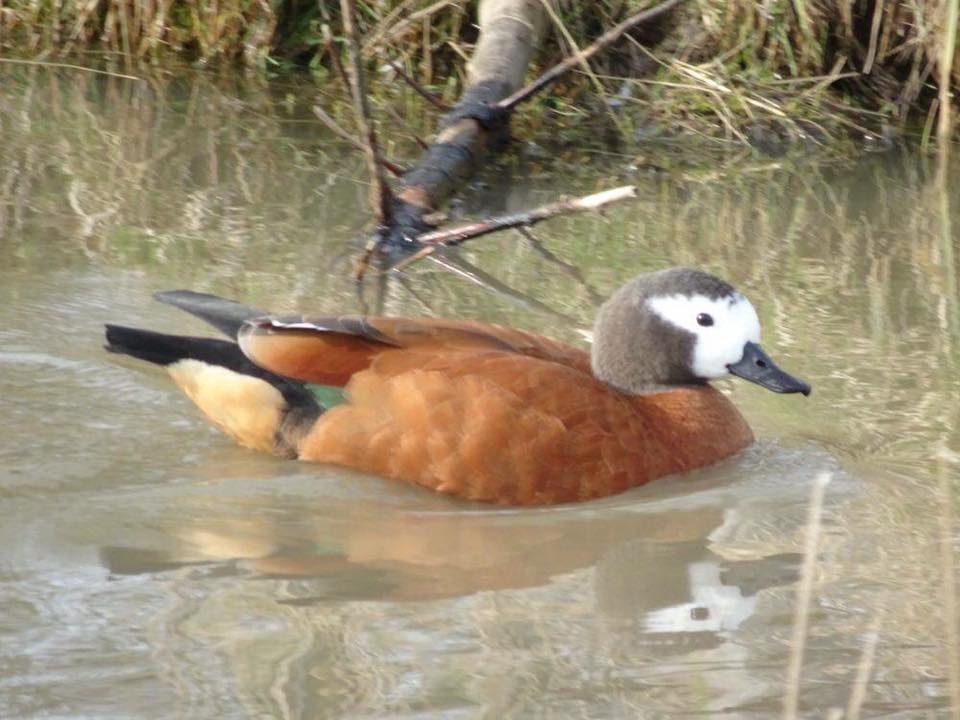
South African Shelduck (Tadorna cana)
Species name
- Dutch name:
- Grijskop casarca
- English name:
- South African shelduck or Cape shelduck
- German name:
- Graukopfkasarka
- French name:
- Tadorne
- Scientific name:
- Tadorna cana
Scientific classification
- Order:
- Anseriformes
- Family:
- Anatidae
- Onderfamilie:
- Tadorninae
- Genus:
- Tadorna
Description
- Description:
Male:
Ashy-grey head and neck. Rusty- orange under parts, paler on breast and under tail- converts, richer toned on flanks especially, belly. Upperparts similar, paler on mantle; rump, upper tail -converts and tail black. Primaries and primary converts black, lightly glossed green, seconderies with stronger green iridescence forming speculum behind with forewing, feathers of which are washed creamy-yellow . under wing all black with primaries. Bill, legs and feet blackish grey.Female:
Darker slate-grey head with very variable amount of white, which can be restricted to a patch around the eye or cover the whole front half of the head, with extension behind eye, or, occasionally, virtually whole of head. Darker, richer- colored on body then male and less pale on breast. Occasionally pink blotches on feet.Juvenile:
Duller over all, with grey - brown tinge very apparent , including on forewing; no green on speculum. Molts into more adult plumage during first winter, with white appearing on head of juvenile female.
Standard Measurements
- Body Length (cm):
- The male (drake) of the South African Shelduck measures approximately 61-66 centimeters. The female measures approximately 61-66 centimeters.
- Body Weight (grams):
- The male will weight about 1225-1545 gram. The female will weight about 1225-1545 gram.
The weight is notoriously variable and can only be used as indication!
- Habitat:
This species needs large, deep ponds and dense swampy vegetation and nearby grassland.
- Note:
Nests are lined with grass, down and feathers. The breeding starts in the dry season, begins June/July. Breeding is as solitary pair.
- Breeding:
- The female South African Shelduck usually lays from 5-15 creamy white eggs and incubates them for 28-32 days.
- Artificial incubating:
The ideal relative humidity for incubating most waterfowl eggs is 55% (ground nesters) and 40% (cavity nesters). The temperature is usually 37.4°C. Set ventilation as recommended by the incubator manufacturer. Eggs must be turned, either automatically or by hand, a minimum of 4 times a day. As the duckling develops there is a loss of water from the egg and the air sac gets bigger. In normal development of an egg with a 28-32 days incubation, the air sac occupies about a third of it three days earlier. Cleanliness is vital and ideally eggs should be moved to a separate hatcher at this point, where the humidity should be increased to 65% and even higher once they have pipped internally.
- Bird banding:
- Recommended closed leg band ring size for the South African Shelduck is 13 mm.The leg band ring can only be applied on a young species of shelduck at around 14 days old.
- It doesn't matter what leg that you band, but it's good to have a consistent system. Suggested: Left leg = Female, Right leg = Male
- Maintenance food:
-



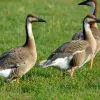

Lundi Regular with a protein content of 20%, valuable Spirulina and high-quality by-products is optimally balanced in its composition maintenance food for water ornamental fowl of all kinds. Especially green teal and Whistling ducks that are not dependent on a very high protein content, are well supplied.
Lundi Regular contains all the minerals and vitamins in full form that are important for the animals. Therefore also suitable as breeding food.


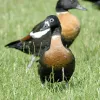


Floating full food for all sea ducks, green ducks, eider ducks and geese, especially in the moulting and breeding phase ideally suited. Packed with wholesome raw materials, natural vitamins and trace elements, this performance food with a protein content of 30% forms the basis for lifelong vitality.
